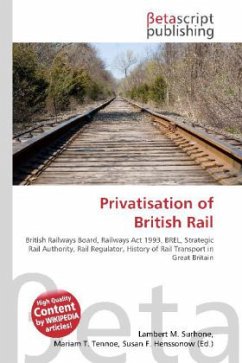Please note that the content of this book primarily consists of articles available from Wikipedia or other free sources online.The privatisation of British Rail was set in train when the Conservative government enacted, on the 19th January 1993, the British Coal and British Rail (Transfer Proposals) Act 1993 (c3). This enabled the relevant Secretary of State to issue directions (as to the disposal of holdings) to the relevant Board. This was necessary since (in the case of the British Railways Board) they had to Act, at all times, within the rules established by various Transport and Railways acts - none of which would have allowed the Board to ''sell-off'' any of its assets. The subsequent direction from the Secretary of State forced the creation of Railtrack PLC. This then paved the way, later that year for the Railways Act 1993 introduced by John Major''s Conservative government. The operations of the British Railways Board (BRB) were broken up and sold off. This process was very controversial at the time, and the Labour opposition announced its intention to re-nationalise the railways, although this has not been implemented by the subsequent Labour government. The manner in which privatisation was carried out has also received criticism for its complexity.
Bitte wählen Sie Ihr Anliegen aus.
Rechnungen
Retourenschein anfordern
Bestellstatus
Storno








